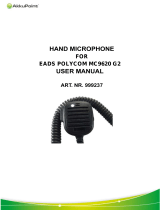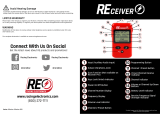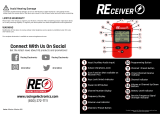Page is loading ...



Technical Information Updates
As we continue to make engineering enhancements to our products, the information in our
Service Manuals need to be updated accordingly. If you wish to be informed of these
updates, kindly fill in and fax us your details.
Manual No.:68007024004
Kindly complete the Service Manual Feedback Form on the next page to help us ensure
that you receive the most accurate and complete information.
Fax to: 6-04-6124944
The Technical Publications Coordinator,
Global Customer Documentation,
R&D Department,
Motorola Penang.
Your Details
N a m e / C o n t a c t P e r s o n :
Company Name:
Address:
Telephone No.:
Fax No.:
Email Address:
How would you like to receive the update notification?
Through:
mail email fax

Service Manual Feedback Form
We believe that reports from users provide valuable information for producing quality
manuals. Kindly take a few moments to provide feedback on this manual. Thank you for
your cooperation.
1. Please check all the appropriate boxes:
2. How do you rate this particular Service Manual?
excellent very good good fair poor
3. Did this Service manual provide you with the information necessary to service and
maintain the specific equipment?
very much so generally yes to some extent no
4. We would appreciate any corrections or recommendations for improving this manual.
Please include the specific page number(s) of the diagram or procedure in question.
5. General comments/suggestions:
Manual No.:68007024004
Fax to: 6-04-6124944
The Technical Publications Coordinator,
Global Customer Documentation,
R&D Department,
Motorola Penang.
Complete
Incomplete
Correct
Incorrect
Clear
Confusing
Size
Adequate
Size
Too Small
Not Covered
in this Manual
Disassembly
Procedures
Alignment
Procedures
Exploded
Views
Schematic
Diagrams
Circuit Board
Details
Electrical Parts
List
Exploded View
Parts List

i
COPYRIGHT
Copyrights
© 2008, 2009 by Motorola, Inc. All rights reserved.
No part of this manual may be reproduced, transmitted, stored in a retrieval system, or translated into any
language or computer language, in any form or by any means, without the prior written permission of Motorola
Inc.
Computer Software Copyrights
The Motorola products described in this manual may include copyrighted Motorola computer programs stored in
semiconductor memories or other media. Laws in the United States and other countries preserve for Motorola
certain exclusive rights for copyrighted computer programs including, but not limited to, the exclusive right to
copy or reproduce in any form the copyrighted computer program. Accordingly, any copyrighted Motorola
computer programs contained in the Motorola products described in this manual may not be copied, reproduced,
modified, reverse-engineered, or distributed in any manner without the express written permission of Motorola.
Furthermore, the purchase of Motorola products shall not be deemed to grant either directly or by implication,
estoppel, or otherwise, any license under the copyrights, patents or patent applications of Motorola, except for
the normal non-exclusive royalty-free license to use that arises by operation of law in the sale of a product.
Trademarks
MOTOROLA and the Stylized M Logo are registered in the U.S.Patent and Trademark Office. All other product or
service names are the property of their respective owners.

ii
SAFETY
Product Safety and RF Exposure Compliance
ATTENTION!
This is restricted to occupational use only to satisfy ICNIRP RF energy exposure
requirements. Before using this product, read the RF energy awareness information and
operating instructions in the Quick Reference Card enclosed with your radio (Motorola
Publication part number 68007024011) to ensure compliance with RF energy exposure limits.
For a list of Motorola-approved antennas, and other accessories, visit the following web site
which lists approved accessories: http://www.motorola.com/business
These servicing instructions are for use by qualified personnel only. To reduce the
risk of electric shock, do not perform any servicing other than that contained in the
Operating Instructions unless you are qualified to do so. Refer all servicing to
qualified service personnel.
Before using this product, read the operating instructions for safe usage contained
in the Quick Reference Card enclosed with your radio.

iii
DOCUMENT HISTORY
The following major changes have been implemented in this manual since the previous edition:
Edition Description Date
68007024004-A Initial edition Oct. 2008
68007024004-B Added VHF 136 – 174 MHz information Feb. 2009

iv
Notes

Table of Contents v
Table of Contents
Copyright ........................................................................................................ i
Safety ............................................................................................................. ii
Document History ........................................................................................ iii
Chapter 1 Model Charts and Test Specifications .............................. 1-1
1.1 Radio Model Information................................................................................................................ 1-1
1.2 Model Chart for UHF2, 435–480 MHz ........................................................................................... 1-2
1.3 Model Chart for VHF, 136–174 MHz ............................................................................................1-3
1.4 UHF2 Specifications ...................................................................................................................... 1-4
1.5 VHF Specifications ........................................................................................................................ 1-5
Chapter 2 Theory Of Operation ........................................................... 2-1
2.1 Introduction .................................................................................................................................... 2-1
2.2 Major Assemblies .......................................................................................................................... 2-1
2.2.1 Receiver............................................................................................................................ 2-1
2.2.1.1 RX Front End ..................................................................................................... 2-2
2.2.1.2 RX Back End ..................................................................................................... 2-2
2.2.1.3 RX Squelch........................................................................................................ 2-3
2.2.2 Transmitter........................................................................................................................ 2-3
2.2.3 Phase Lock Loop Synthesizer .......................................................................................... 2-4
2.2.4 RX Audio Circuit ............................................................................................................... 2-5
2.2.5 TX Audio Circuit................................................................................................................ 2-6
2.2.6 Microcontroller .................................................................................................................. 2-7
2.2.7 Power Supply.................................................................................................................... 2-7
Chapter 3 Test Equipment, Service Aids, and Service Tools........... 3-1
3.1 Test Equipment.............................................................................................................................. 3-1
3.2 Service Aids................................................................................................................................... 3-2
Chapter 4 Performance Checks .......................................................... 4-1
4.1 General .......................................................................................................................................... 4-1
4.2 Power–Up Self Test....................................................................................................................... 4-1
4.3 LCD/LED/Button/Volume Knob Test Mode.................................................................................... 4-1
Chapter 5 Radio Programming and Tuning ....................................... 5-1
5.1 Introduction .................................................................................................................................... 5-1
5.2 CPS Programming Setup .............................................................................................................. 5-1
5.3 Radio-to-Radio Cloning ................................................................................................................. 5-1
5.4 Radio Tuning Setup ....................................................................................................................... 5-2
5.4.1 Initial Test Equipment Control Settings............................................................................. 5-3

vi Table of Contents
5.5 Transmitter Alignment Options ...................................................................................................... 5-3
5.5.1 Transmit High Power Tuning ............................................................................................ 5-4
5.5.2 Transmit Low Power Tuning ............................................................................................. 5-5
5.5.3 Transmit Modulation Tuning ............................................................................................. 5-6
5.5.3.1 Transmit 12.5 kHz Modulation Tuning ............................................................... 5-6
5.5.3.2 Transmit 25 kHz Modulation Tuning .................................................................. 5-7
5.6 Receiver Tuning.............................................................................................................................5-8
5.6.1 Receive 12.5 kHz-Band Normal Squelch Tuning.............................................................. 5-8
5.6.2 Receive 12.5 kHz-Band Tight Squelch Tuning ................................................................. 5-9
5.6.3 Receive 25 kHz-Band Normal Squelch Tuning............................................................... 5-10
5.6.4 Receive 25 kHz-Band Tight Squelch Tuning .................................................................. 5-11
5.7 Utilities ......................................................................................................................................... 5-12
5.7.1 Program Serial No. .........................................................................................................5-12
5.8 Front Panel Feature and Button Configuration Mode .................................................................. 5-12
5.8.1 Introduction ..................................................................................................................... 5-12
5.8.2 Entering Programming Mode .......................................................................................... 5-12
5.8.3 Exiting Programming Mode............................................................................................. 5-12
5.8.4 Accessing Front Panel Programming Mode Parameters................................................ 5-12
5.8.5 Editing Front Panel Programming Mode Parameters ..................................................... 5-13
Chapter 6 Maintenance – CP185 ........................................................ 6-1
6.1 Introduction .................................................................................................................................... 6-1
6.2 Preventive Maintenance ................................................................................................................ 6-1
6.2.1 Inspection.......................................................................................................................... 6-1
6.2.2 Cleaning Procedures ........................................................................................................6-1
6.3 Safe Handling of CMOS and LDMOS Devices .............................................................................. 6-2
6.4 Disassembling and Reassembling the Radio – General................................................................ 6-3
6.4.1 Radio Disassembly – Detailed .......................................................................................... 6-4
6.4.1.1 Front Housing From Chassis Disassembly........................................................ 6-4
6.4.1.2 Chassis Assembly Disassembly ........................................................................ 6-7
6.4.1.3 Front Circuit Board, Display Module and Keypad Disassembly......................... 6-8
6.4.1.4 Speaker Disassembly ........................................................................................ 6-9
6.4.2 Radio Reassembly – Detailed......................................................................................... 6-11
6.4.2.1 Speaker Reassembly....................................................................................... 6-11
6.4.2.2 Front Circuit Board, Display Module and Keypad Reassembly ....................... 6-11
6.4.2.3 Chassis Assembly Reassembly....................................................................... 6-12
6.4.2.4 Chassis and Front Housing Reassembly......................................................... 6-14
6.5 Torque List ...................................................................................................................................6-14
6.6 Mechanical View and Parts List ................................................................................................... 6-15
6.6.1 CP185 View and Parts List ............................................................................................. 6-15
Chapter 7 Troubleshooting Tables ..................................................... 7-1
7.1 Error Codes.................................................................................................................................... 7-1
7.2 Troubleshooting Table for Receiver............................................................................................... 7-2
7.3 Troubleshooting Table for Transmitter........................................................................................... 7-3

Table of Contents vii
Appendix A Accessories .........................................................................A-1
Appendix B Warranty, Service Support, and Replacement Parts .......B-1
B.1 Scope of Manual............................................................................................................................B-1
B.2 Warranty ........................................................................................................................................B-1
B.2.1 Warranty Period and Return Instructions..........................................................................B-1
B.2.2 After Warranty Period .......................................................................................................B-1
B.2.3 Piece Parts .......................................................................................................................B-2
Appendix C Repair Procedures and Techniques – General ................C-1
Glossary of Terms..................................................................................... G-1

viii Table of Contents
Notes

Table of Contents ix
List of Figures
Figure 2-1. Receiver Block Diagram................................................................................................... 2-1
Figure 2-2. Transmitter Block Diagram............................................................................................... 2-3
Figure 2-3. PLL Synthesizer Block Diagram....................................................................................... 2-4
Figure 2-4. RX Audio Block Diagram.................................................................................................. 2-5
Figure 2-5. TX Audio Block Diagram .................................................................................................. 2-6
Figure 3-1. Programming/Test Cable (PMDN4077_R)....................................................................... 3-3
Figure 3-2. Cloning Cable (PMDN4076_R) ........................................................................................ 3-3
Figure 3-3. Wiring of the Connectors.................................................................................................. 3-3
Figure 4-1. LCD Indication.................................................................................................................. 4-1
Figure 5-1. CPS Programming Setup ................................................................................................. 5-1
Figure 5-2. Radio Tuning Setup.......................................................................................................... 5-2
Figure 5-3. Tx High Power Window (High Power) .............................................................................. 5-4
Figure 5-4. Tx Low Power Window (Low Power)................................................................................ 5-5
Figure 5-5. Tx Modulation 12.5 kHz Window...................................................................................... 5-6
Figure 5-6. Tx Modulation 25 kHz Window......................................................................................... 5-7
Figure 5-7. Rx 12.5 kHz-band Normal Squelch Tuning Window ........................................................ 5-8
Figure 5-8. Rx 12.5 kHz-band Tight Squelch Tuning Window............................................................ 5-9
Figure 5-9. Rx 25 kHz-band Normal Squelch Tuning Window ......................................................... 5-10
Figure 5-10. Rx 25 kHz-band Tight Squelch Tuning Window............................................................. 5-11
Figure 5-11. Program Radio Serial No. Window................................................................................. 5-12
Figure 6-1. Limited Keypad With Channel Knob Model...................................................................... 6-3
Figure 6-2. Battery and Antenna Removal ......................................................................................... 6-4
Figure 6-3. Knobs Removal ................................................................................................................ 6-5
Figure 6-4. Chassis Removal ............................................................................................................. 6-5
Figure 6-5. Speaker Wire and Flexible Cable Connection.................................................................. 6-6
Figure 6-6. Speaker Wire Removal .................................................................................................... 6-6
Figure 6-7. Unlatch the Flexible Cable ............................................................................................... 6-7
Figure 6-8. Sub-Circuit Board and Accessory Bracket Removal ........................................................ 6-7
Figure 6-9. Main Circuit Board, O-ring and Battery Contact Seal Removal........................................ 6-8
Figure 6-10. Front Circuit Board Removal ............................................................................................ 6-8
Figure 6-11. LCD and Keypad Removal............................................................................................... 6-9
Figure 6-12. Speaker Removal........................................................................................................... 6-10
Figure 6-13. Speaker Reassembly ..................................................................................................... 6-11
Figure 6-14. LCD and Keypad Reassembly ....................................................................................... 6-11
Figure 6-15. Front Circuit Board Reassembly .................................................................................... 6-12
Figure 6-16. Main Circuit Board, O-ring and Battery Contact Seal Reassembly ................................ 6-13
Figure 6-17. Sub Circuit Board and Accessory Bracket Reassembly................................................. 6-13
Figure 6-18. Chassis Assembly and Front Housing Assembly Reassembly ...................................... 6-14
Figure 6-19. CP185 Exploded View.................................................................................................... 6-15

x Table of Contents
List of Tables
Table 1-1. Radio Model Number (Example:AAH03RDF8AA7AN)..................................................... 1-1
Table 3-1. Recommended Test Equipment ....................................................................................... 3-1
Table 3-2. Service Aids...................................................................................................................... 3-2
Table 4-1. Radio Operation in Test Mode..........................................................................................4-1
Table 5-1. Initial Equipment Control Settings ....................................................................................5-3
Table 5-2. Transmit High/Low Power Level....................................................................................... 5-3
Table 5-3. Transmit Modulation Tuning ............................................................................................. 5-6
Table 5-4. Receiver Squelch Tuning ................................................................................................. 5-8
Table 5-5. Front Panel Programming Mode Parameters................................................................. 5-13
Table 6-1. Torque Chart .................................................................................................................. 6-14
Table 7-1. Error Code Display ........................................................................................................... 7-1
Table 7-2. Receiver Troubleshooting Table....................................................................................... 7-2
Table 7-3. Transmitter Troubleshooting Table................................................................................... 7-3
Table C-1. Lead Free Solder Wire Part Number List ........................................................................ C-1
Table C-2. Lead Free Solder Paste Part Number List....................................................................... C-1
Related Publications
NAG
CP185 Series Radios User Guide (English, French Canadian) ........................6878080A01
CP185 Series Radios Quick Reference Card (English, French Canadian)..... 68007024011
CP185 Series Basic Service Manual............................................................... 68007024004

Notations Used in This Manual xi
Notations Used in This Manual
Throughout the text in this publication, you will notice the use of the following notations. These notations
are used to emphasize that safety hazards exist, and due care must be taken and observed.
Note:
An operational procedure, practice, or condition that isessential to emphasize.
CAUTION indicates a potentially hazardous situation which, if not avoided,
might result in equipment damage.

xii Summary of Bands Available
Summary of Bands Available
Table below lists all the bands available in this manual. For details, please refer to the Model Charts section.
Frequency Band Bandwidth Power Level
UHF2 435 – 480 MHz 2W or 4W
VHF 136 – 174 MHz 2W or 5W

Chapter 1 Model Charts and Test Specifications
1.1 Radio Model Information
The model number and serial number are located on a label attached to the back of your radio. You
can determine the RF output power, frequency band, protocols, and physical packages. The example
below shows one portable radio model number and its specific characteristics.
Table 1-1. Radio Model Number (Example:AAH03RDF8AA7AN)
Regional
Prefix
Type of
Unit
Model
Series
Freq. Band
Power
Level
Physical
Packages
Channel
Spacing
Protocol
Feature
Level
Version
Letter
Unique
Variation
AA H 03 R
UHF
(435 – 480 MHz)
K
VHF
(136 – 174 MHz)
D
4 W
E
5 W
F
Limited
Keypad with
Channel
Knob
8
12.5/25k
AA 7
No
Front Panel
Prog.
with
Scrambling
AN
AA = NAG
H = Portable
03 = CP Family Model Series
AA = Conventional
N = Standard Package

1-2 Model Charts and Test Specifications: Model Chart for UHF2, 435–480 MHz
1.2 Model Chart for UHF2, 435–480 MHz
CP185, UHF2, 435 – 480 MHz
Model Description
AAH03RDF8AA7AN CP185 435 – 480M 4W 12.5/25K 16C
Item Description
X PMUE3139_ CP185 435 – 480M 4W 12.5/25K 16C
X PMDE4023_R 435 – 480M 4W PCB – PMUE3139_AN
X PMDN4131_R Front Circuit Board, LKP
X PMDN4128_R Sub Circuit Board, w Channel
X 68007024004 Sub Circuit Board, w Channel
X = Indicates compatibility with model(s)

Model Charts and Test Specifications: Model Chart for VHF, 136–174 MHz 1-3
1.3 Model Chart for VHF, 136–174 MHz
CP185, VHF, 136 – 174 MHz
Model Description
AAH03KEF8AA7AN CP185 136 – 174M 5W 12.5/25K 16C
Item Description
X PMUD2444_ 136 – 174M 5W 12.5/25K 16CH
X PMDD4020_R 136 –174M 5W PCB – PMUD2444_AN
X PMDN4131_R Front Circuit Board, LKP
X PMDN4128_R Sub Circuit Board, w Channel
X 68007024004 CP185 Series – Basic Service Manual
X = Indicates compatibility with model(s)

1-4 UHF2 Specifications
1.4 UHF2 Specifications
General
Self-Quieter Frequencies
Transmitter
Receiver
All specifications are subject to change without notice.
UHF2
Frequency: 435 – 480 MHz
Channel Capacity: 16 Channels
Power Supply: 7.5 Volts ±20%
Dimensions:
(H x W x D)
with
High Capacity Li-Ion
NiMH Std
Li-Ion Std
Batteries:
120 mm x 55 mm x 40.7 mm
120mm x 55mm x 36.5mm
120mm x 55mm x 35.5mm
Weight:
16 Channel Model
Batteries:
High Capacity Li-Ion
NiMH Std
Li-Ion Std
342.0g
394.5g
335.0g
Average Battery Life
@ (5-5-90 Duty
Cycle):
High Capacity Li-Ion
NiMH Std
Li-Ion Std
Capacity
(mAh)
2150
1300
1500
4 W
12 Hrs.
8 Hrs.
8 Hrs.
2 W
14 Hrs.
10 Hrs.
10 Hrs.
UHF2
446.44
446.445
455.895
456.01
456.015
456.125
458.195
460
467.785
467.9
468.01
468.125
468.24
470
479.9
UHF2
RF Output
NiMH @ 7.5 V:
Low
2 W
High
4 W
Frequency: 435 – 480 MHz
Channel Spacing: 12.5/25 kHz
Freq. Stability:
(-30°C to +60°C)
0.00025%
Spurs/Harmonics: -36 dBm < 1 GHz
-30 dBm > 1 GHz
Audio Response:
(from 6 dB/oct.
Pre-emphasis, 300 to
3000 Hz)
+1, -3 dB
Audio Distortion:
@ 1000 Hz, 60%
Rated Max. Dev.
<5%
FM Noise: <-40 dB
UHF2
12.5 kHz
UHF2
25 kHz
Frequency: 435 – 480 MHz
Sensitivity
12 dB EIA SINAD:
0.25 μV (typical)
Adjacent Channel
Selectivity:
-65 dB -70 dB
Intermodulation: -70 dB
Freq. Stability
(-30°C to +60°C):
0.00025%
Spur Rejection: -70 dB
Image and 1/2 I-F
Rejection:
-70 dB
Audio Output
@ <5% Distortion:
500 mW
/


